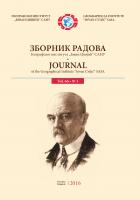The Wind As An Important Aspect And Its Impact On Population Trends And Demographic Conditions In Tripolitania During Late Pleistocene/Early Holocene
The Wind As An Important Aspect And Its Impact On Population Trends And Demographic Conditions In Tripolitania During Late Pleistocene/Early Holocene
Author(s): Mirjana Nešić, Amran KhalifaSubject(s): Archaeology, Geography, Regional studies, Recent History (1900 till today), Demography and human biology
Published by: Географски институт »Јован Цвијић« САНУ
Keywords: Wind; Pleistocene; and Holocene;
Summary/Abstract: The vast majority of Tripolitania sites are open surface sites, but after the introduction of paleoclimatology in archaeological research during 1980’s, even with the insufficient amount of research, we were given a new vision of the archaeology of the region in regards to technology, adaptation, and behaviourism. The archaeological study of the region has developed within its own right, producing individual characteristics, including the sub-regional parts of Northern Africa. From the 1990’s up through today, the archaeology of Tripolitania has benefited from these new developments with the introduction of climatology inclusive of geology, physical anthropology with genetic data, and the new methods of chronology and interpretations of cultural activities. This article will attempt to show the importance of the introduction of climatology and geomorphology in the study of surface sites where systematic excavations for whatever reasons had not been possible, yet certainly preferred. The geographical positioning of the sites in correlation with their surroundings, and the appearance and composition of the sediments in context with the archaeological artefacts, could provide us with valuable information about the connection between the cultures that inhabited this region. With these developments in research, we are now able to trace the cultural evolution of Tripolitania by paying particular attention to periods impacted by climate change (particularly wind), which had caused new geological and geomorphological conditions that forced the individuals of this culture to adapt in order to survive.
Journal: Зборник радова Географског института "Јован Цвијић" САНУ
- Issue Year: 66/2016
- Issue No: 3
- Page Range: 335-352
- Page Count: 18
- Language: English

